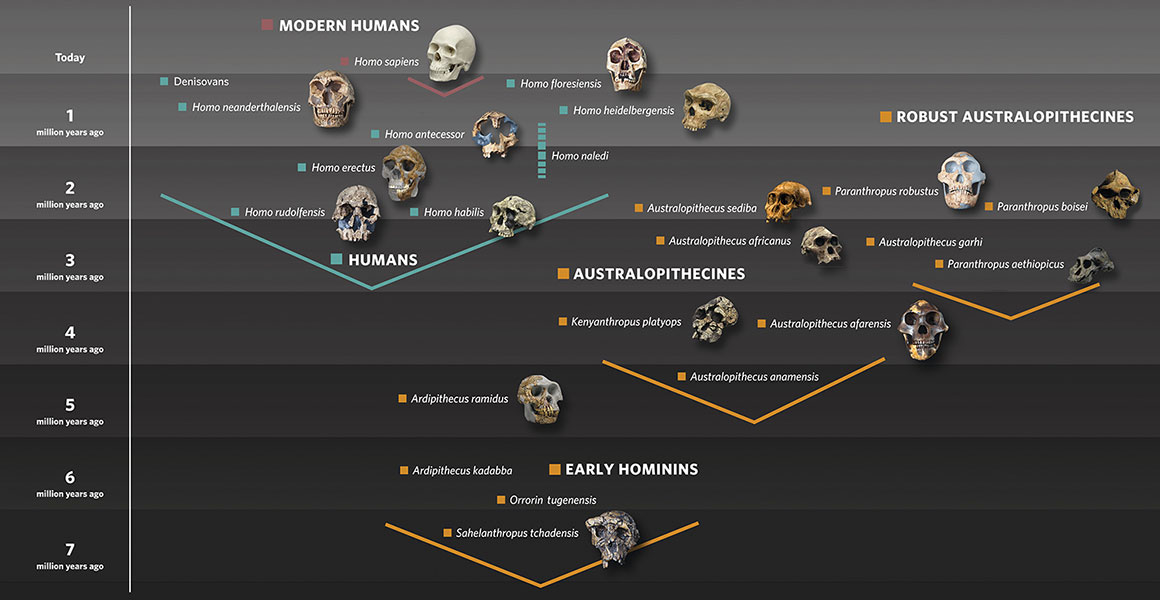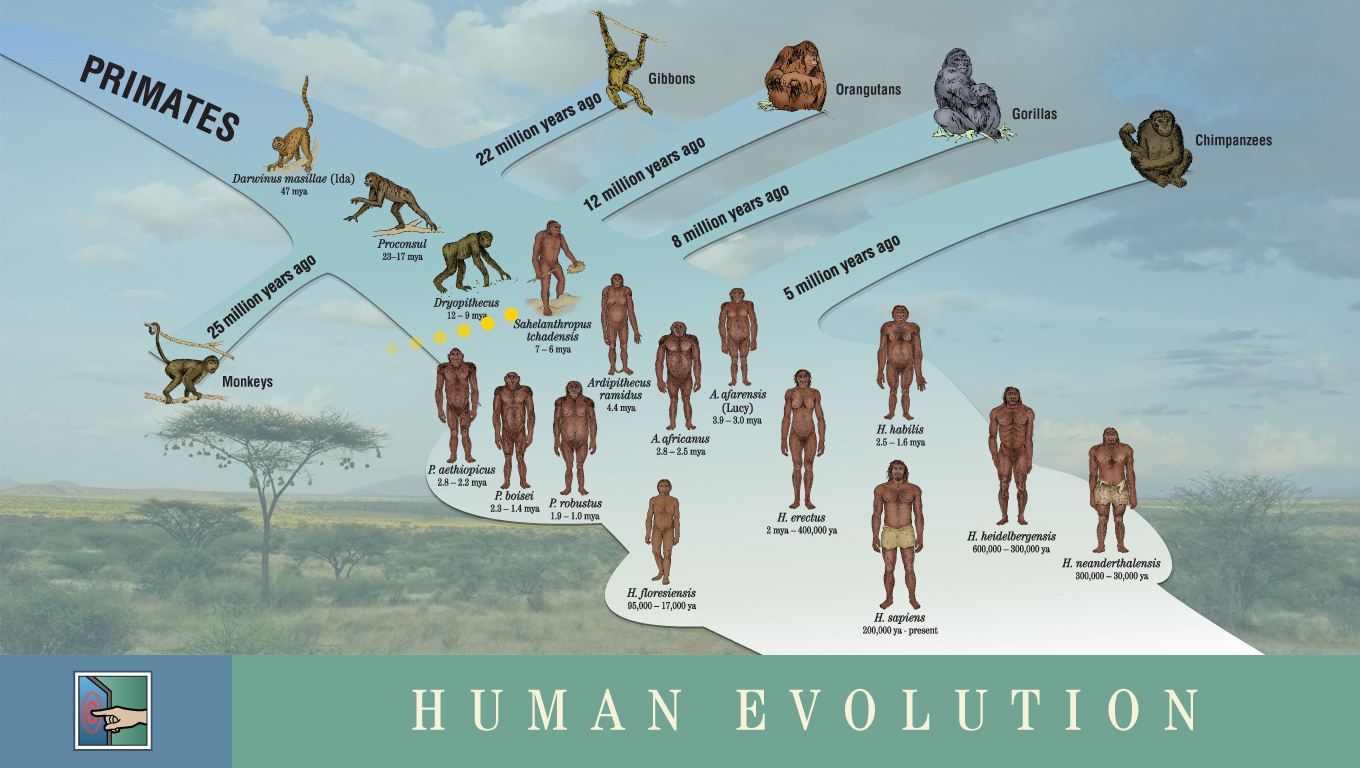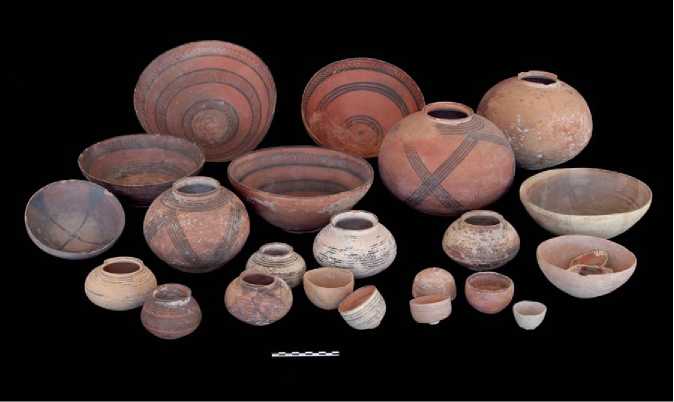 |
| PC Pinterest |
Food is indispensable for human survival. Much attention is being paid to what people ate during the evolutionary stages and it serves as a guideline to what we should eat today. Food experts say modern humans should eat from a Stone Age menu. After examining the diets of ancient hunter-gatherers, the food experts concluded that 73 percent of these primitive societies derived more than half of their calories from meat,
Since 'food history' focuses cultural, economic, environmental and sociological impacts of food, the field is interdisciplinary in its scope. On the other hand 'culinary history' is a traditional field and it is distinct from 'food history.' Culinary history focuses on the origin and recreation of ancient cuisine. Food historians view food as an essential elements of culture, reflecting the social and economic structure of the society.
Human evolution is the evolutionary process of change by which anatomically modern humans originated from ape-like ancestors. Before Homo sapiens evolved, our hominin (an early form of human or any taxonomic tribe) ancestors foraged for millions of years. Hominins relied on food available from nature and gathered plants, small animals, birds, and insects. They were scavenging animals killed by other predators and also resorted to primitive hunting. Control of fire is considered as the significant step made by hominins. Cooked food brought amazing transformation: it provided more nutrition, reduced chewing time, and constricted him with smaller intestines and, as a result, cooked food contributed to brain development. Cooking and primitive agriculture provided social living. Evolved human improved taste in their cooking. Specific practice or manner of cooking food brought the 'art of cooking' or 'culinary art.' Sangam Tamil Cuisine is one such culinary art. "Gastronomy governs the whole life of man."
This five part series aims to explicate the Food in Sangam literature.
Food in Sangam literature 1: Evolution of Man and His Early Civilizations, Egypt, Mesopotamia and Indus Valley.
Food in Sangam literature 2: Introduction to Ethnic Culture.
Food in Sangam literature 3: Rice and Millets in Sangam Tamil Cuisine.
Food in Sangam literature 4: Meat in Sangam Tamil Cuisine.
Food in Sangam literature 5: Food Habits in Five Sangam Landscapes.
Food in Sangam literature 4: Meat in Sangam Tamil Cuisine.
Food in Sangam literature 5: Food Habits in Five Sangam Landscapes.
Early Human: The Evolution of Foraging
Australopithecus is an extinct genus of the hominid family that lived in Africa from about three to two million years ago. Australopithecus means “southern ape.” It was one of the longest-lived and best-known early human species and ancestor of humans. It was originally a herbivore. Between 2.5 and 2 million B.C., ancient human was forced by drought and commenced eating some meat to supplement their diet. They foraged by scavenging small crawling animals and insects. Scavenging was the only means of foraging and not necessarily by hunting initially.
Homo habilis (meaning 'handy man') is considered as the earliest 'great ape' type creature. Homo-habilis is generally accepted as the earliest member of the genus Homo and it is now extinct. The species is following Australopithecus and preceding Homo-erectus. The earliest Homo species inhabited parts of sub-Saharan Africa about 2 million to 1.5 million years ago. It is believed that this was the earliest human species to make tools for specific purposes i.e., to cut meat etc.,
By 1.9 million years ago, Homo erectus (meaning 'upright man'), formerly known as Pithecanthropus erectus, had evolved into a new, fully grown human species in African tropics. The species was "having upright stature and a well-evolved post-cranial skeleton, but with a smallish brain, low forehead, and protruding face." By about 500,000 years ago, he began to gradually migrate into Asia and parts of Europe. He was probably also the first to use fire. We think that Homo erectus built campfires and may have made simple ovens with hot stones.
Homo sapiens (Latin "wise man') belongs to the species of bipedal primates to which modern human belong. Homo is the human genus, that also includes Neanderthals and various extinct species of Hominin. Homo sapiens is the lone surviving species of the genus Homo. Modern humans belongs to the sub species of Homo sapiens. H. sapiens are characterized by bipedal stance and gait, brain capacity averaging about 1400 cc (82 cubic inches), high forehead, small teeth and jaw and defined chin, They depended upon verbal and non-verbal communication and devised and utilized complex tools. Homo sapiens first appear in the fossil record about 200,000 years ago.
Until agriculture was developed around 10,000 years ago, all humans got their food by hunting, gathering, and fishing. As farming emerged, nomadic hunter-gatherers were gradually pushed off towards prime farmland
 |
| PC: Natural History Museum |
 |
| PC: Ken hokes human evolution timeline |
The discovery of fire, or, more precisely, the controlled use of fire was one of the earliest of human discoveries. The purposes of fire are multiple, some of which are to add light and heat and to cook plants and animals.
 |
PC Saved from tle.westone.wa.gov.au
|
Richard Wrangham, a professor of biology and anthropology at Harvard University, argues that cooking was the breakthrough technological innovation that allowed humans to support big brains resulting in the first human, Homo erectus. According to him cooking provided more calories for existing and reduced the caloric cost of digestion. Homo sapiens evolved from the ability of digesting cooked food with more intake of starches, meat and connective tissue which increases the number of calories in the food available to the human digestive system. Control of fire changed the course of human evolution, allowing our ancestors to stay warm, cook food, ward off predators and venture into harsh climates. It also had important social and behavioral implications, encouraging groups of people to gather together and stay up late. It was regarded by Darwin as the greatest discovery made by humanity.
Egyptian Civilisation
 |
| Royal Bakery Ramesses III PC: Wikimedia Commons |
They cultivated barley and emmer, (a kind of cereal) as well as vegetables and fruits including melons, peas, fava beans, fenugreek and lentils along the Nile valley. They learned to cook bread and beer and cereals and added honey and dates to sweeten their food and drink. They harvested honey from wild forests and even domesticated bees kept in pottery hives. The women engaged in beer distillation. Wine was also consumed by the people. They also used grains either as currency to pay taxes or wages or to barter. Egyptians were known for food preservation methods. They constructed 'great silos' to preserve grain for long periods of time and drying and salting practices were employed for fish, vegetables and fruits.
Mesopotamian Civilization
 |
| PC: Historymartinez's Blog |
 |
| PC: Hankering for History |
Sumerians lived in the southernmost part of ancient Mesopotamia which is generally considered the cradle of civilization. Barley, wheat, millet were used as the staple food in the Sumerians diet. It also included chick peas, lentils and beans; onions, garlic and leeks; cucumbers, cress, mustard and fresh green lettuce. Their daily meals comprised barley cake (bread) or barley paste accompanied by onions or beans soaked in barley ale and fish. Meat was consumed in cities than in countryside. and it gets spoiled very quickly due to hot environment.. Instead beef and veal were popular everywhere since people could afford them.
They were characteristically inventive and evolved the first writing well before 3000 B.C. They wrote on clay tablets and evolved the script known as cuneiform, or "wedge-shaped." Sumerians were also credited for the first written recipes i.e., bilingual Sumerian-Akkadian word lists. These archaeological sources cite the importance of barley bread, of which many varieties are referred, and barley and wheat cakes, and grain and legume soups; of onions, leeks and garlic; of vegetables including chate melon, and of fruits including apple, fig and grape; of honey and cheese; of several culinary herbs; and of butter and vegetable oil. Sumerians more often drank beer and consumed wine occasionally. Wine was well known in northern Mesopotamia. Animal meat consisted of pork, mutton, beef, fowl including ducks and pigeons, and many varieties of fish. Meat was salted and preserved; fruits were conserved in honey; several foods, including apples, were dried. A kind of fermented cause is identified in Akkadian texts.
Mesopotamians cultivated onions, leeks and garlic plants. Barley was their main crop. Rice and corn were unknown to them and wheat cultivation flourished in less saline soil. The fruit cultivation included apples, apricots, cherries, figs, melons, mulberries, pears, plums, pomegranates, and quinces. Barley bread was very popular food stuff. Date was an important fruit crop and date palms were domesticated in southern Mesopotamia,
Indus Valley Civilization
 |
| Principal Sites of Indus Valley Civilization PC: Encyclopedia Brittanica |
The Indus or Harappan civilization belongs to the Chalcolithic or Bronze Age civilization. Discovery of the objects of copper and stone were found around 1400 Harappan sites. It is known as Harappan civilization since it was discovered first in 1921 at the modern site of Harappa, situated in the province of west Punjab in Pakistan. Sir John Marshall was the first person to use the term ‘Indus civilization.’ Evidence of pottery has been found in the early settlements of Mehrgarh from the Indus Valley Civilization. Terracotta pots of all shapes and sizes were found in various Indus Valley sites.
 |
| Indus Valley Pottery PC: The Cultural Landscape Through Time |
 |
| Cooper Seals PC: Ancient Asia |
 |
| Economy PC: River Valley Civilization |
People used pots to carry and store many different types of liquids and grains. Copper and bronze plates were also discovered, probably utilized exclusively by wealthy upper class city dwellers. Wheat and barley were used as main staple food and prepared bread as well as gruel or porridge. At certain sites, particularly Gujarat, Indus valley people cultivated some native millets i.e., possibly broom-corn millet. Wild rice was used as fodder for cattle and for this purpose they even cultivated the same crop. However rice does not formed part of their cultivation. They cultivated lentils and other pulses i.e., peas, chickpeas, green gram, black gram etc., Indus valley people must have consumed wide range of fruits, vegetables and spices including: a variety of brassica, brown mustard greens, coriander, dates, jujube, walnuts, grapes, figs, mango, okra, caper, sugarcane, garlic, turmeric, ginger, cumin and cinnamon. The granaries discovered in Indus valley sites points out that cereals were produced in large quantity. It is interesting to take note of bones of wild species such as boar,deer,and gharial (a.k.a the gavial), and the fish-eating crocodile, in Indus valley. Yet another interesting discovery was banana and it is not clear whether banana was cultivated in the Harappan region or obtained through trade.
Indus valley civilization people were mostly non-vegetarians and very few of them were vegetarians. The people consumed meat and there are evidences to show the funeral offerings made for the deceased and also evidences exist that some people in Harappan sites consumed beef. Archaeological excavations of number of artefact such as sling balls of clay, copper fish hooks, the arrow heads, the flying knives etc stand as evidence that the Indus valley people used these tools for hunting or fishing. It is also evident that Indus valley people were not only hunters and fishermen but also farmers. They consumed meat and included chicken, wild fowl, venison, antelopes, porcupine, beef, pork, rams, shellfish, fish etc.,.
"In all civilizations we've studied, all cultures that we know of across the Earth and across time have invested some kind of attempt to understanding where where, where they come from, and where they are going." Neil deGrasse Tyson In Time, Earth, Understanding
Reference
- A Brief History of Cooking With Fire by Rebecca Rupp http://theplate.nationalgeographic.com/2015/09/02/a-brief-history-of-cooking-with-fire/
- Ancient Civilizations for Kids. https://sites.google.com/site/1ancientcivilizationsforkids/ancient-iraq-mesopotamia
- Ancient Egypt by Joshua J. Mark. 02 September 2009. http://www.ancient.eu/egypt/
- Ancient Egypt. Food Timeline http://www.foodtimeline.org/foodfaq3.html#egypt
- Ancient Man and His First Civilizations: Homo-habilis, Homo-erectus, Homo-sapien-sapien. http://realhistoryww.com/world_history/ancient/Homo_habilis_erectus_neanderthal.htm
- Agyptian Civilization: Daily Life - Food http://www.historymuseum.ca/cmc/exhibitions/civil/egypt/egcl02e.shtml
- Babylon. http://www.ancient.eu/babylon/
- Beef Eating in the Ancient Tamizhagam. K. V. Ramakrishna Rao (A paper presented during the 57th session of Indian History Congress held at Madras from December 27-29, 1996). July 7, 2013. http://beef.sabhlokcity.com/2013/07/beef-eating-in-the-ancient-tamizhagam/
- Changes in the Indian menu over the ages http://www.thehindu.com/seta/2004/10/21/stories/2004102100111600.htm
- Cooking https://en.wikipedia.org/wiki/Cooking
- Eating Meat. Paul Cooijmans. http://paulcooijmans.com/evolution/eating_meat.html
- Foraging: Life as a Hunter-Gatherer https://www.khanacademy.org/partner-content/big-history-project/early-humans/how-did-first-humans-live/a/foraging
- History of Cooking https://allthatcooking.com/history-of-cooking/
- History of Cooking https://hubpages.com/food/history-of-cooking
- History of India upto 8th century https://sol.du.ac.in/mod/book/view.php?id=1611&chapterid=1637
- Indian food http://quatr.us/india/food/
- Indian History Congress held at Madras from December 27-29, 1996). July 7, 2013. http://beef.sabhlokcity.com/2013/07/beef-eating-in-the-ancient-tamizhagam/
- Man Entered the Kitchen 1.9 Million Years Ago By Jennifer Welsh http://www.livescience.com/15688-man-cooking-homo-erectus.html
- Mesopotamia. http://www.ancient.eu/Mesopotamia/
- Sumer. http://www.ancient.eu/sumer/
- The Sumerians and Mesopotamia https://www.khanacademy.org/humanities/ancient-art-civilizations/ancient-near-east1/sumerian/a/the-sumerians-and-mesopotamia
- What was the food eaten in ancient/Vedic India? https://www.quora.com/What-was-the-food-eaten-in-ancient-Vedic-India
YouTube